Mesothelioma Statistics
Mesothelioma statistics reveal that it is a rare cancer with about 3,000 people diagnosed each year. Mesothelioma mainly occurs around the lungs, heart or abdomen. The latency period for pleural and peritoneal mesothelioma is 20 to 60 years.
Written byMichelle Whitmer•Edited ByWalter Pacheco•Medically Reviewed ByDr. Jacques Fontaine
Asbestos.com is the nation’smost trustedmesothelioma resource
The Mesothelioma Center at Asbestos.com has provided patients and their loved ones the most updated and reliable information on mesothelioma and asbestos exposure since 2006.
Our team of Patient Advocates includes a medical doctor, a registered nurse, health services administrators, veterans, VA-accredited Claims Agents, an oncology patient navigator and hospice care expert. Their combined expertise means we help any mesothelioma patient or loved one through every step of their cancer journey.
More than 30 contributors, including mesothelioma doctors, survivors, health care professionals and other experts, have peer-reviewed our website and written unique research-driven articles to ensure you get the highest-quality medical and health information.
About The Mesothelioma Center at Asbestos.com
- Assisting mesothelioma patients and their loved ones since 2006.
- Helps more than 50% of mesothelioma patients diagnosed annually in the U.S.
- A+ rating from the Better Business Bureau.
- 5-star reviewed mesothelioma and support organization.
Testimonials
My family has only the highest compliment for the assistance and support that we received from The Mesothelioma Center. This is a staff of compassionate and knowledgeable individuals who respect what your family is experiencing and who go the extra mile to make an unfortunate diagnosis less stressful. Information and assistance were provided by The Mesothelioma Center at no cost to our family.LashawnMesothelioma patient’s daughter
How to Cite Asbestos.com’s Article
APA
Whitmer, M. (2023, September 29).Mesothelioma Statistics.Asbestos.com. Retrieved October 11, 2023, from //www.magnakarsa.com/mesothelioma/statistics/
MLA
Whitmer, Michelle. "Mesothelioma Statistics."Asbestos.com, 29 Sep 2023, //www.magnakarsa.com/mesothelioma/statistics/.
Chicago
Whitmer, Michelle. "Mesothelioma Statistics." Asbestos.com. Last modified September 29, 2023. //www.magnakarsa.com/mesothelioma/statistics/.
Key Facts About Mesothelioma
Knowing key mesothelioma statistics helps you better understand this disease and spread awareness. Learning about the therapies to treat it can ensure you make educated decisions about your health.
- Mesothelioma is a rare type of cancer that develops in the lining of the lungs (pleura) and chest wall. It also occurs in the lining of the abdomen (peritoneum) or the tissue surrounding the testes (tunica vaginalis) or heart.
- The four types ofmesotheliomaare pleural, peritoneal, pericardial and testicular.
- Out of all people with heavy, prolonged exposure to asbestos, 8% to 13% develop mesothelioma.
- 研究表明,再多的石棉暴露afe. The risk of developing mesothelioma is highest among asbestos workers who endured years of exposure, but it may develop in people with limited exposure.
- Symptoms of mesothelioma do not show up until 20-60 years after asbestos exposure. Symptoms develop after tumors have grown and spread.
- The average life expectancy for mesothelioma patients is 12 to 22 months.
- In 2019, mesothelioma accounted for 0.16% of all U.S. cancer diagnoses, according to the U.S. Centers for Disease Control and Prevention.
Who Gets Mesothelioma?
Men older than age 65 with a blue-collar or military background are most at risk for mesothelioma. That’s because blue-collar industries and all branches of the U.S. military used asbestos products. However, anyone with a history ofasbestos exposureis at risk.
Occupations at Greatest Risk of Asbestos Exposure
- Chemical refining
- Construction
- Firefighting
- Manufacturing
- Military service
- Power generation
- Shipbuilding
Secondary asbestos exposure is a risk for family members of asbestos workers. This exposure has led to mesothelioma in spouses and children of asbestos workers.
The chances of developing mesothelioma from asbestos exposure increase with continued exposure. This is called a dose-response relationship. Asbestos workers with years of exposure have an 8% to 13% risk of mesothelioma. However, it’s possible that a person could develop mesothelioma from a single, heavy exposure to asbestos.
Mesothelioma Incidence by Demographic
Mesothelioma incidencedescribes the risk of developing mesothelioma cancer. The most recent year of cancer incidence data available from the U.S. Centers for Disease Control and Prevention and the Surveillance, Epidemiology, and End Results Program is from 2019.
Mesothelioma Incidence by Gender
In 2019, mesothelioma was 2.8 times more likely to occur in men than women. Research and historical data show that men were more likely than women to hold jobs that used asbestos.
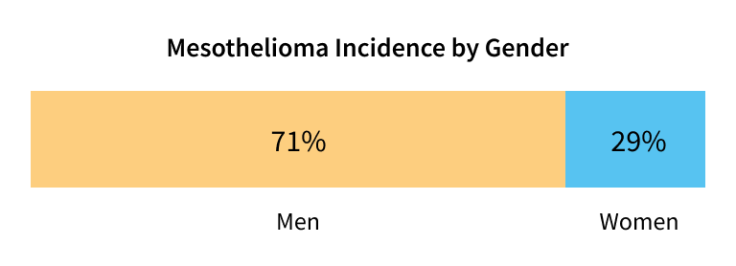
Of the 2,911 mesothelioma cases diagnosed in 2019, men accounted for 2,141 cases and women accounted for 770 cases. That means approximately 74% of mesothelioma cases occurred in men and 26% occurred in women.
Mesothelioma Incidence by Race/Ethnicity
Of all diagnosed patients in 2019, approximately 91% were white. The CDC’s 2019 ethnicity data shows Hispanic people with mesothelioma accounted for approximately 10% of cases.
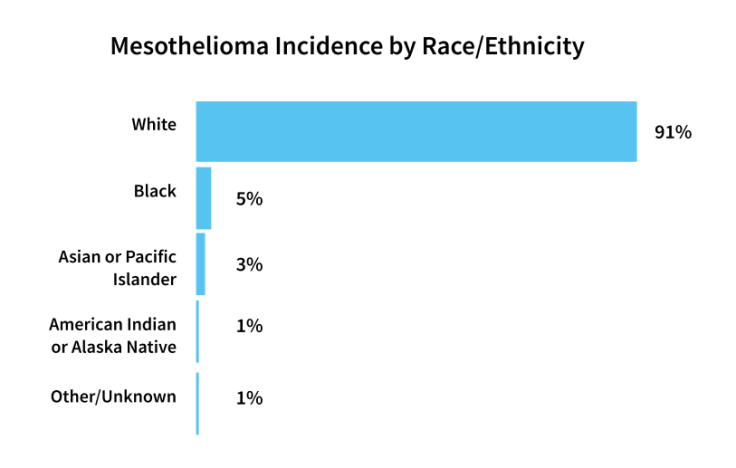
定期,美国劳工部发布s summary statistics about the U.S. workforce. The reports show that Black workers are highly represented in health and education services, public administration and transportation sectors. They were less likely to be employed in occupations that used asbestos, such as building and ship construction, insulation work and mining.
Furthermore, historically fewer Black individuals have served in the U.S. Navy, which has been a significant source of asbestos exposure for men.
Mesothelioma Incidence by Age
In 2019, the CDC reported that most people with mesothelioma are diagnosed between ages 75 and 80. The risk of developing mesothelioma is 10 times higher for those older than 60 compared to those younger than 40.
The average age at diagnosis is the result of the 20- to 60-year latency period between first exposure to asbestos and the development of mesothelioma. This long latency period means older people are more likely to develop the disease.
The latency period is generally shorter for peritoneal mesothelioma than pleural mesothelioma. Most people diagnosed with peritoneal and pleural mesothelioma are about 51 and 67 years old, respectively.

How Long Does Mesothelioma Take to Develop?
Mesothelioma starts to develop 20 to 60 years after exposure to asbestos. Thelatency periodis the gap between first exposure and the appearance of symptoms.
Mesothelioma Latency Period by Gender
According to researchers, women tend to experience lower levels of asbestos exposure, which may explain their longer latency period. In contrast, men have a higher likelihood of exposure to asbestos in their occupations. Men often worked jobs in construction, power generation and factories where they were exposed to high concentrations of asbestos for extended periods of time.

Researchers also say women are typically associated with secondhand asbestos exposure, which generally occurs at lower levels and for shorter durations. These lower levels of exposure are linked to a longer latency period, although the specific type of mesothelioma may also influence this period.
Average Latency Periods by Mesothelioma Type
The average latency period for pleural mesothelioma is 30 to 60 years. For peritoneal mesothelioma, it is 20 to 40 years.

Researchers do not understand why the latency period is shorter for peritoneal mesothelioma.

Mesothelioma Statistics by Tumor Location
Most mesothelioma cases occur in thepleura, the tissue surrounding the lungs. About 20% of cases appear in theperitoneum, which is the lining of the abdomen.
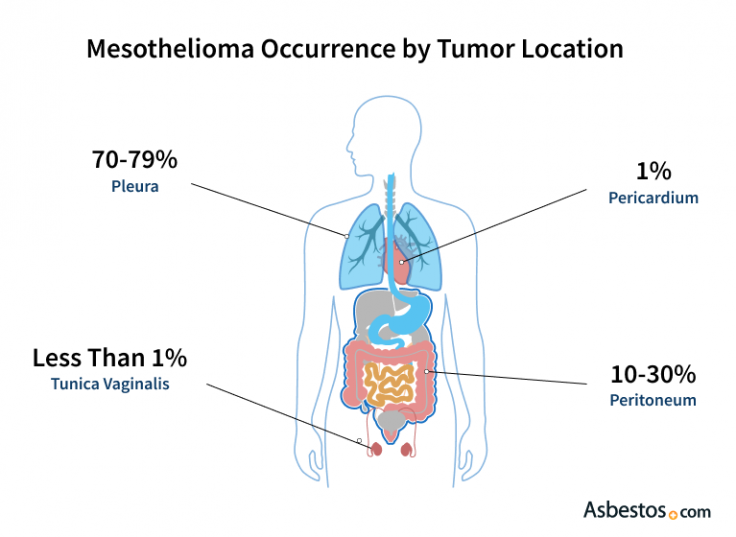
In 1% of cases, this cancer forms in the lining of the heart, called the pericardium. Fewer than 1% of cases occur in the tunica vaginalis, which is the covering of the testes.
Symptoms by Tumor Location
Mesothelioma symptomsvary depending on where this cancer forms.
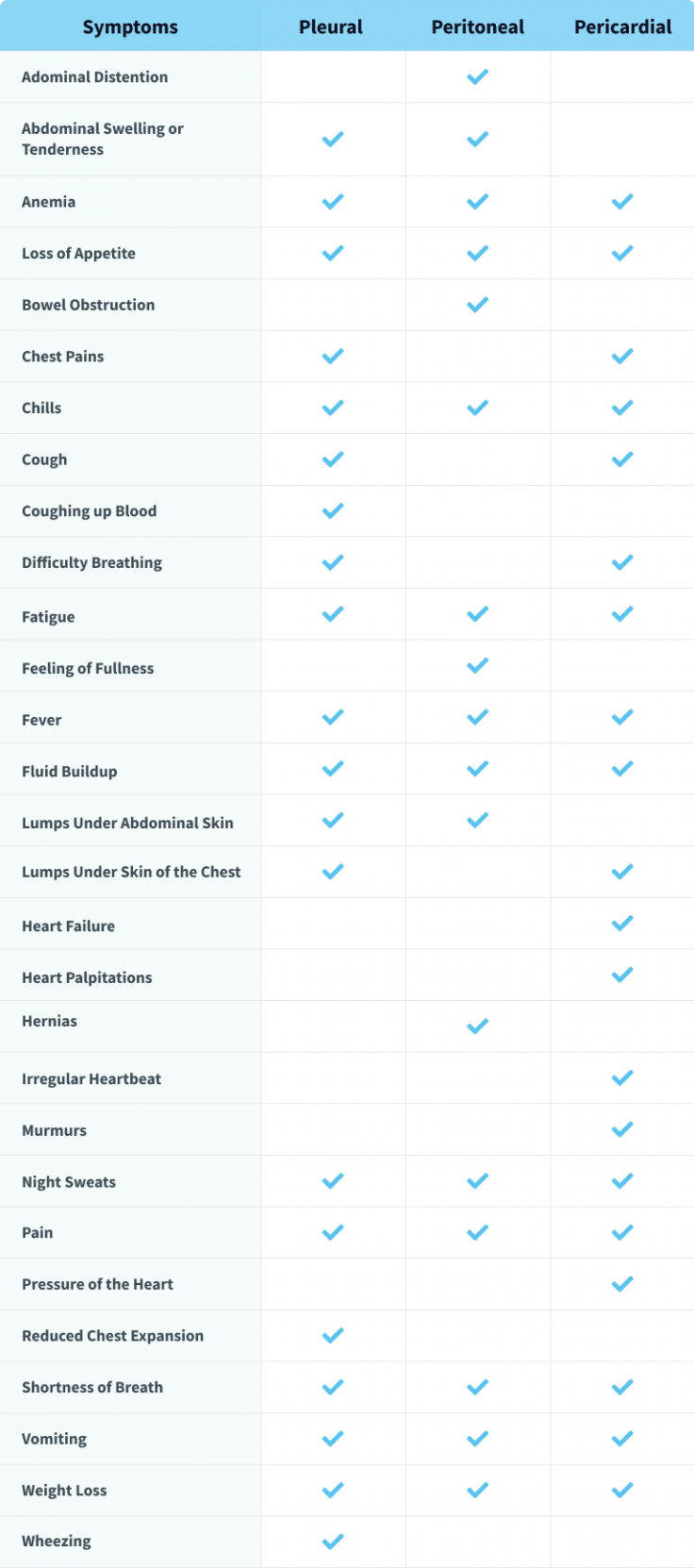
早期症状通常是轻微或nonexistent. This factor makes mesothelioma challenging to catch early.
Mesothelioma Survival and Mortality Rate Statistics
Mesothelioma survival and mortality rates are similar. The number of people diagnosed with the disease each year resembles the number of annual deaths. Average life expectancy is about one year.
The prognosis for mesothelioma is generally poor compared to other cancers. But the prognosis is better for certain types of mesothelioma. Half of peritoneal patients who undergo aggressive treatment live longer than five years.
Survival Rate by Mesothelioma Type
Survival rates vary significantly among the different types of mesothelioma. Medical advances have made peritoneal mesothelioma easier to treat than pleural mesothelioma.
A 2015 study from Translational Oncology reveals a large difference insurvival rates. Most patients survive a year after diagnosis, but peritoneal patients see longer survival rates.
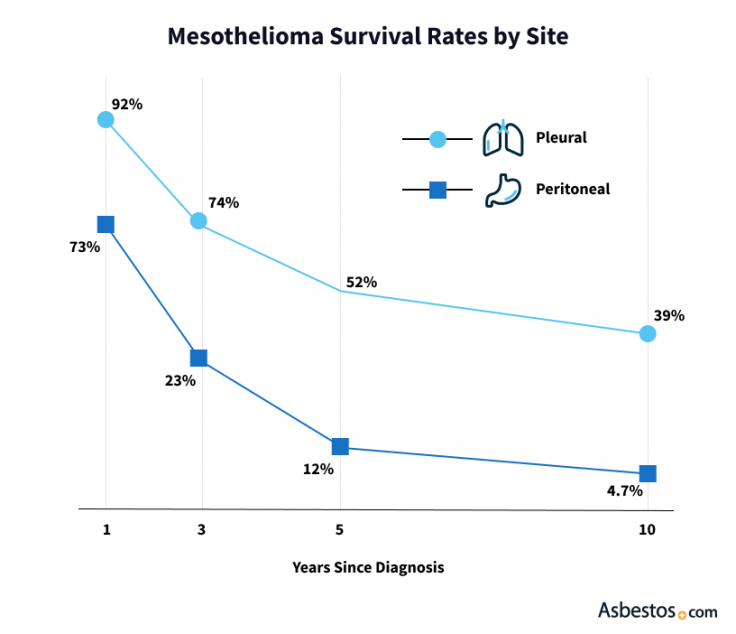
More survival rate data is available for pleural mesothelioma because it is the most common type. For example, researchers have analyzed pleural survival by stage of tumor progression.
由Pleur平均存活时间al Mesothelioma Stage
医生胸膜间皮瘤病例分类整理stages to describe how far the cancer has spread. Themesothelioma stageat diagnosis affects the patient’s treatment options and prognosis.
| Mesothelioma Stage | Median Survival Time |
|---|---|
| Stage 1 | 22.2 months |
| Stage 2 | 20 months |
| Stage 3 | 17.9 months |
| Stage 4 | 14.9 months |
Patients have more treatment options and a better prognosis in the early stages. As tumors progress, treatment options diminish and prognosis worsens.
5-Year Survival Rates for Pleural Mesothelioma
The Surveillance, Epidemiology, and End Results Program tracks 5-year survival rates. Pleural mesothelioma has three groups: Localized, regional and distant stages.
| SEER Stage | 5-Year Survival Rate |
|---|---|
| All SEER Stages | 10% |
| Localized | 18% |
| Regional | 12% |
| Distant | 7% |
When compared to patients with distant tumors, those with localized tumors are more than twice as likely to live at least five years.
5-Year Survival Rate for Peritoneal Mesothelioma
The SEER program tracks and publishes survival rate data for pleural mesothelioma but not for the peritoneal type. This is likely because pleural cases far outnumber peritoneal cases.
Researchers at Wake Forest University School of Medicine evaluated 380 mesothelioma patients. They reported a 5-year survival rate of 65.3% for peritoneal mesothelioma.
| Year(s) | Peritoneal |
|---|---|
| 1 year | 91.6% |
| 3 years | 73.8% |
| 5 years | 65.3% |
| 10 years | 39.4% |
Long-term survival is better in peritoneal cases because treatment is more effective.
Mesothelioma Survival Rates by Demographic
Survival among women diagnosed with pleural mesothelioma is higher compared to men. The 5-year survival rate for men with pleural mesothelioma is 7.3% compared to 16.4% for women.
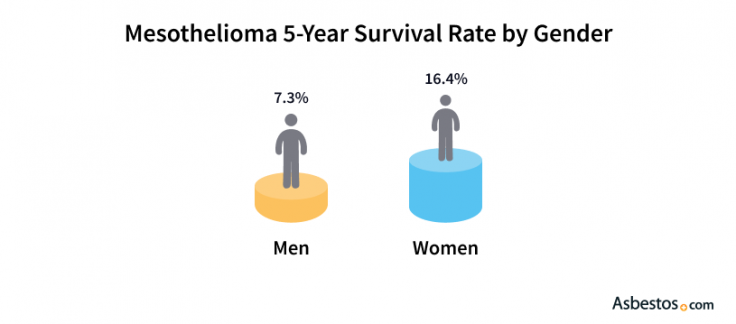
Overall, younger mesothelioma patients have a significantly higher survival rate than older patients. More than 50% of patients diagnosed before the age of 50 survive one year, while less than 33% of those 75 or older survive the same length of time.
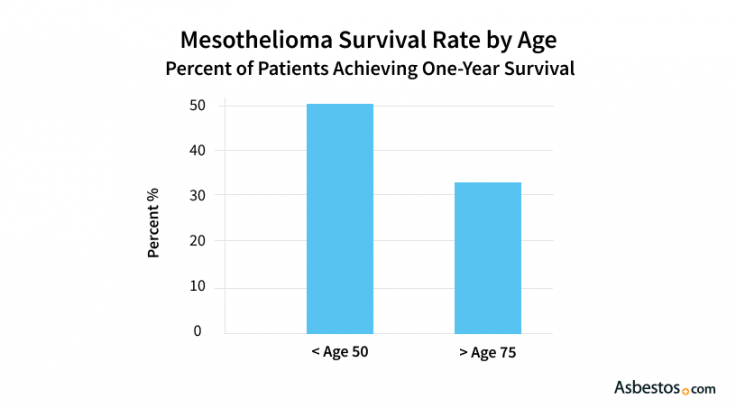
The 5-year survival rate differs by race. In 2015, which is the most recent year for compiled data by race, the 5-year survival rate was 18.6% for Black people and 9.4% for those who are white.
Mortality Statistics for Mesothelioma
The mortality rate for mesothelioma is about 0.8 cases per 100,000 people. This is according to data collected from 1999 to 2020 by the CDC. During that period, a total of 54,905 Americans died from mesothelioma.
In 2017, the CDC released a more in-depth mortality report on mesothelioma data collected from 1999 to 2015. According to the report:
- Approximately 45,221 Americans died from mesothelioma between 1999 and 2015.
- Nearly 80% of those deaths were men.
- About 37% of deaths were people between ages 75 and 84.
The death rate for mesothelioma is close to the incidence rate, which is 0.7 cases per 100,000 people.
Mesothelioma Death Rate by State, 1999-2015
The mesothelioma mortality rate varies throughout the United States. Higher rates exist in areas with a strong history of industrial work and manufacturing.

Data collected from 1999 to 2015 remains the most current mortality rate data available for mesothelioma by state.

Mesothelioma Treatment Statistics
Mesothelioma treatmentmay involve surgery, chemotherapy and radiation therapy. Patients may also enroll in clinical trials for emerging treatments such as immunotherapy.Mesothelioma is a complex disease, and few doctors have experiencediagnosingand treating it. Mesothelioma specialists offer patients the best options.

- More than 80% of patients receive chemotherapy, the most common treatment for mesothelioma.
- Chemotherapy may triple the survival rate of mesothelioma patients, according to a2016 study of SEER data.
- Less than 20% of pleural mesothelioma patients qualify for aggressive tumor-removing surgery.
- Half of peritoneal mesothelioma patients who receive HIPEC surgery live longer than five years.
Research has shown improved survival with multimodal therapy. This approach combines two or more treatments.
A 2018 study presented at the eighth annual European Lung Cancer Congress showed a combination of surgery, chemotherapy and radiation produced a 1-year survival rate of 79.6% for pleural mesothelioma patients.
Combining surgery with chemotherapy is also effective for peritoneal mesothelioma. A 2018 International Journal of Hyperthermia study showed median disease-free survival was almost five years for peritoneal patients receiving HIPEC surgery. The median overall survival was more than eight years.
Only about 20% of pleural mesothelioma patients are eligible for aggressive tumor-removing surgery. Researchers are testing new drug regimens for those who do not qualify for surgery. These include drugs already used in lung cancer treatment.
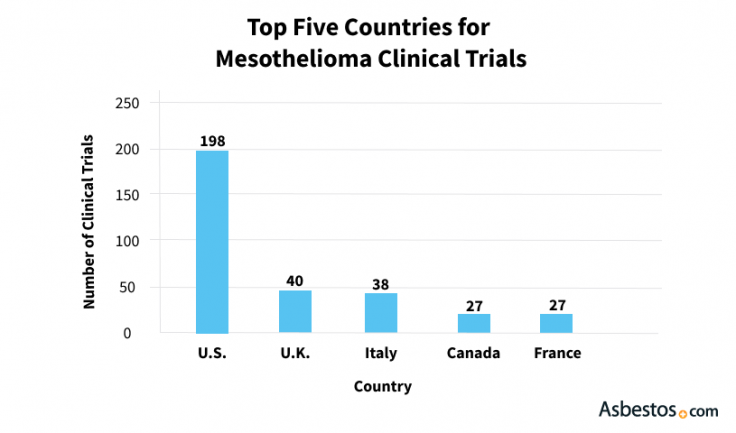
Human studies, called clinical trials, give patients access to the latest breakthroughs in treatment. Researchers have conducted more than 300 clinical trials for mesothelioma worldwide.
Mesothelioma Cost and Compensation Statistics
Treatment for mesothelioma is not easily affordable for most families. Compensation is available to help patients pay for cancer treatment and related health care costs.

- Costs: $60,000.National Cancer Institute statistics estimate the cost of lung cancer treatment at more than $60,000 for the first year. Mesothelioma treatment costs are comparable.
- Claims: $1 million to $2.4 million.The average mesothelioma trial payout is around $2.4 million, according to a 2016 Mealey’s Litigation Report. The average settlement ranges from $1 million to $1.4 million. A 2022 analysis from consulting firm KCIC shows 1,793 mesothelioma lawsuits were filed in 2021.
- Trusts: $30 Billion.In 2016, the RAND Corporation’s Institute for Civil Justice reported asbestos bankruptcy trusts hold a combined total of more than $30 billion. These trusts have paid claimants roughly $20 billion since the late 1980s.
Families use mesothelioma compensation to cover various expenses such as medical bills, lost wages, travel costs and other losses. In addition to mesothelioma compensation, some people qualify for other forms of financial aid, such as VA benefits and Social Security Disability Insurance.
Additional Cancer Statistics Resources
Additional information and statistics are available from the following cancer resources.
- International Agency for Research on Cancer: IARC promotes international collaboration in cancer research. It works to identify carcinogenic substances.
- World Health Organization: WHO reports cancers are among the leading causes of death worldwide.
- National Cancer Institute: NCI reports on cancer statistics about incidence, treatment and survival.
- American Lung Association: ALA has facts about lung cancer prevalence, mortality and more.
Additional information can be found at local hospitals, cancer centers and nonprofit cancer organizations.









